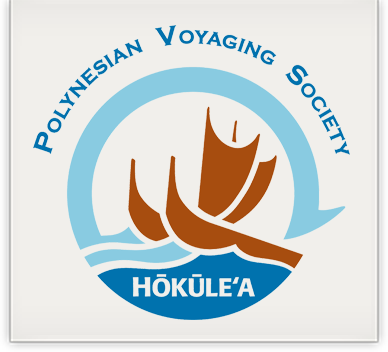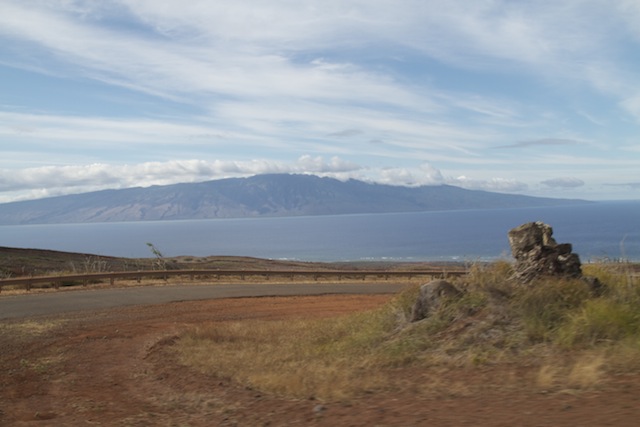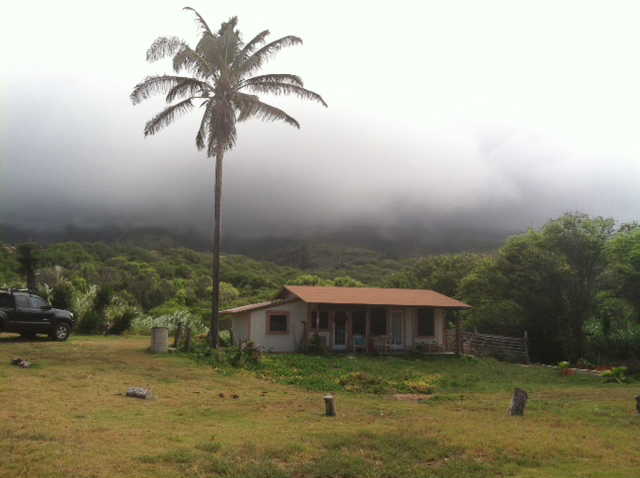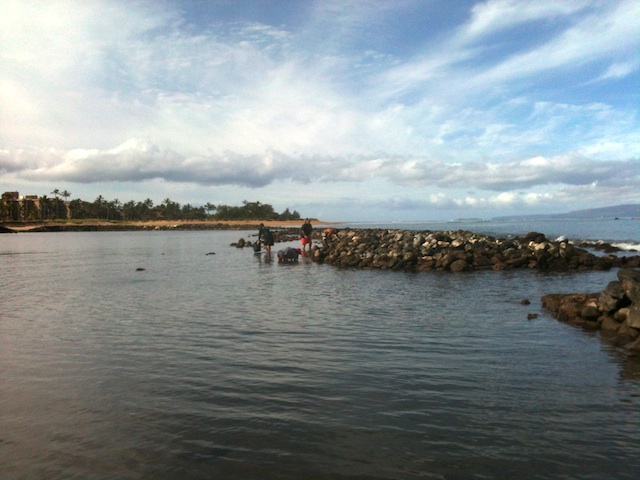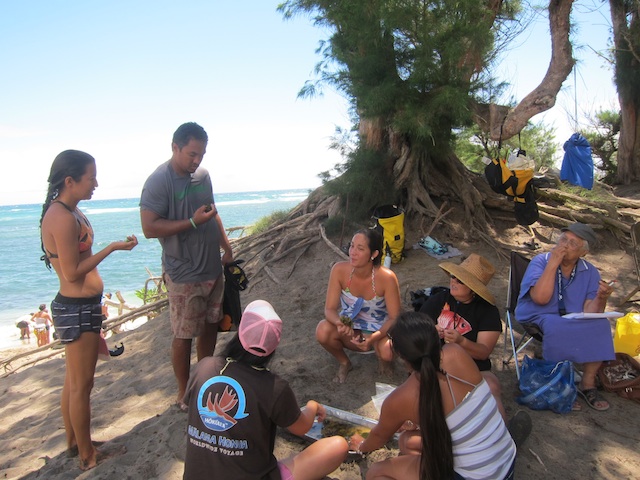Learning Journey: Maunalei Ahupua’a Community Marine & Terrestrial Management Area, July 5
Lāna‘i (Karen Holman) —
As Hokule’a and Hikianalia set sail across the oceans that connect us all, they become a needle, threading a lei of dedicated communities around the planet that inspire us by their efforts to care for our island Earth. Our journey has only just begun and such caring has been powerfully demonstrated here at home, in the Hawaiian Islands. It was late afternoon on Lanai island, a place exemplary of community and aloha. We traveled in the back of a pick-up truck, reveling in the crisp, clean air of sparsely developed land and enraptured with the view of an expansive ocean, nestled between the islands of Molokai and Maui. Valleys were carved through red earth by the forces of nature and everything felt alive, yet as we made our way down this windy, single lane road, we could see an orange plume of silt in the ocean, hugging the immediate coastline below. We discovered both the reason, as well as an innovative remedy for this silt blanketing the reef during our learning journey to Maunalei Ahupua’a Community Marine and Terrestrial Management Area.
Uncle Sol Kaho’ohalahala began by relaying a conversation that took place several years ago, when Nainoa expressed that if Hokule’a is to carry the message of malama or caring around the world, we must ensure that we too are living examples of Malama Honua at home. The community of Lanai is an extraordinary reflection of this value system. One and a half years ago, Uncle Sol of Lanai and Jay Carpio of Maui were selected by Conservation International as funding recipients for their community based ocean resource management plans and their dedication to be keepers of their own ocean area. Initially, funders wished to focus solely on marine related projects, however, Uncle Sol convinced them otherwise as on an island like Lanai, the ocean and the land must necessarily be managed as one whole, integrated system.
Kaalakahikina
Not only is the community looking from land to sea, but they are also looking from present to future in a comparative study over time. In partnership with the University of Hawaii and Stanford, they are conducting baseline assessments, and have already accomplished 120 dives to record existing fish, seaweed, and coral species. Maunalei is the site of traditional subsistence fishing for generations and a critical resource to the community. To capture its value, community members are participating in pakini or krill surveys to answer questions such as: Who are the fisherman? How many? How often? What methods are used? What do they take, how much, and what do they do with it? This information will help the community determine if their practices are regenerative and sustainable.
Community members are involved in these surveys and encouraged to observe the environment as they monitor activity around this important resource. Noting ocean conditions, or the quality of light, mirrors Hawaiian views of place and time in a system that connects these observations to cycles, posing questions like: is the spawning cycle the best time to fish? Management systems of the past took these elements into account. Maunalei Ahupua’a seeks to improve decision making as a community, without an external law imposing restrictions, but rather allowing the community to drive what is right.
The land of Lanai island is largely denuded of vegetation due to a 100 year history of ranching and ever growing populations of sheep and deer. Heavy rains send large amounts of clay into the ocean and the orange plume we observed from above is now a daily occurrence, churned up with every change of the tides. To address these problems, the community has turned to permaculture, an agricultural design system rooted in the observation of nature and the interconnectedness of all living things.
Uncle Sol and his family are stewards of family Hawaiian lands that have been passed down through the generations. Today, they are applying the natural design of “gabions”- barriers made of kiawe logs laid across a stream bed, acting not as a dam, but rather as a system to slow the flow of the water while still allowing it to permeate through. We visit the site in the perfect timing of late afternoon, and the kiawe grove resembles a labyrinth of golden light and innovative design.
The results of the gabions are incredible. After two large rain events, up to six inches of newly deposited silt had gathered along the sides of the gabions, silt that would have otherwise ended up in the ocean and suffocate the coral reef. Furthermore, Uncle Sol plans to vegetate the area with certain plants to hold the soil in place, interspersed with food plants. The project is addressing not only erosion and sedimentation, but also issues of food security.
Maunalei is an amazing example to help community learn what they can do to be responsible in caring for their ocean by caring for the land. The site is even used as a camp for children, where they learn to be responsible fishermen, how to care for their resources, and how take care of the land. Maunalei Ahupua’a is building a culture of caring as keepers of the land and sea, a classroom without walls, the classroom of place, and of living sustainably in our island homes. Uncle Sol sees a much bigger picture than the four acres he cares for in his ahupua’a. He is aware of the power of providing models of success and if adopted in other streams, the sediment plumes could be stopped in a short period of time. The process did not cost much money, only man power, and this, he says, “is community”. He recognizes the process as intergenerational and critical, as he tells us with passion, “we rely on this land, and it is our collective interest to take care of this land for generations”.
Uncle Sol speaks of the future with personal investment as he holds his beautiful granddaughter on his lap. The keiki (children) today, he notes “have no other view of their home except this. They are quick to define the issues, but ask them how to fix it and it is difficult. We are hoping they do not capture this as their future. We must change that image of what their potential is, change their view of what aina (land) is all about, change this place to be productive again so that they see things differently. Right now they see very little value in the land as it is and this is not the kind of image that gives them any hope.”
Maunalei Ahupua’a provides a special vision of hope for children as an amazing example of community taking charge of their place, a place that has remained within a family for generations. Uncle Sol shows us a slideshow with stirring black and white images of his ancestors. He wants the children to know the Kupuna of this land and realize that we really are following in their footsteps. Although she is very young, Uncle Sol’s granddaughter, Ka’alkahikina has a pensive look in her eyes, as though she is absorbing and contemplating the kuleana she carries for her future.
At the end of our experience we journey to the ocean to visit the place known as Kalaehi, a point that jets out into the ocean and points perfectly into the middle of the Pailolo channel. This special place marks the beginning mo’olelo or story of Lanai island. On a day in the future, I can see an image of people standing at this same point and also speaking of beginnings, beginnings of community action to protect and restore an island that has suffered impacts. As he considers the process of removing those impacts, Uncle Sol poses the question, “Will the aina recover? I think she will” and so too will we as we recover our relationship with the natural world and begin to care for our home in the same way our ancestors always have.
